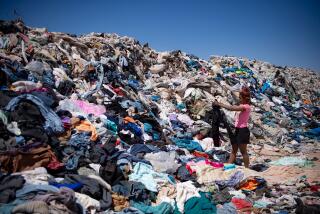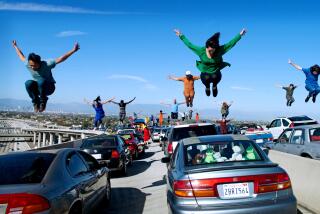Marathon Creates a Garment District
Looking for a smelly sweatshirt? How about a wet hat or dirty gloves? There will be plenty of castaway clothes to choose from during today’s L.A. Marathon, the city’s best-kept secret for free secondhand running gear.
T-shirts, sweatpants, windbreakers--you name it. If a runner wears it, you can probably find it somewhere in the wake of the marathon’s 23,000 participants. While some racers arrange for friends or family to find what they’ve tossed aside, others sense the futility of such an endeavor, and that leaves the rest up for grabs.
“After the pack of runners leaves, the street is just one solid mass of clothing, plastic bags, shoes, sweaters, socks, hats. Anything you can imagine is apt to be found there,” said Brenda Ramsey, the marathon’s start line coordinator for the past 12 years. She estimates that each runner leaves at least one article of clothing at the starting line downtown.
The L.A. Marathon has cleanup trucks and sweepers to whisk away whatever detritus is left over from its runners, but it does not have a formal program for donating the clothing to charity, which some other cities do. After the Boston Marathon, which has about 15,000 participants, volunteers pick up and donate about three tons of clothing. The New York City Marathon collects more than double that amount.
“Sometimes the [starter] gun will go off and you’ll see clothes flying up into the air,” said Hal Higdon, a senior writer for Runner’s World magazine and host of a marathon training Web site. Higdon, who lives in Indiana, ran seven marathons in seven months last year to celebrate his 70th birthday.
Like most marathon trainers, he advises dressing in layers and wearing something on the outside that you don’t care to ever see again. “Everybody’s got an ugly sweatshirt,” he said, “something you might give to a relative who was chilly at the beach but never bother to get back.”
Ed Cogert, 69, has one and is prepared to let it fly, along with a pair of gloves, when he runs his ninth marathon today. “I’ve had it for years,” he said. “You get kind of tired of it, you know? I’ll just use it till I don’t need it anymore.... Hopefully it will get to somebody that needs it.”
Layers are necessary because temperatures can vary up to 20 degrees from the time runners bound across the starting line in the morning until they take their last exhausted step over the finish line in the afternoon. Today’s weather forecast calls for a low of 50 and a high of 71. The starting temperature for last year’s L.A. Marathon was 54 degrees.
Inexperienced marathoners have a tendency to dress for the starting temperature, accounting for neither the changes in their body temperature nor the weather.
“That can get them into trouble,” said Pat Connelly, coach of the L.A. Roadrunners, the L.A. Marathon’s official training group. “When the sun gets brighter and hotter, they find themselves with too much.”
That makes for a strange striptease, one that usually takes place during the first three miles as the runners warm up and strip down, throwing unwanted layers “to the curb or up in the trees or in the bushes,” said L.A. Marathon president Bill Burke.
Burke has been aware of the throwaway clothes phenomenon for about 15 years, he said.
“I know for a fact that there are those who know when the event is, know the route of the event and garner wardrobe from both the start line and along the first couple miles.”
Who are these scavengers, these people watching the runners not for the race but to pick up what they leave behind? The homeless, mostly, or those working on their behalf.
“There’s really some nice clothing. You’d be surprised,” said Connelly, who suggests a more financially viable, if less ecologically sound, alternative as a warmup garment: a garbage bag. That was the clothing choice of many runners during the 2000 L.A. Marathon, which took place in a torrential downpour, but it is also good for the cold.
“It keeps your body warmth inside, and it’s something you can toss away,” Connelly said.
And it solves another problem--of people casting aside their tops with their race numbers.
“I can’t tell you how many times I’ve stood on the finish line [asking] my runners, ‘Where is your number?’ [and heard] ‘I think it’s back on King Boulevard or Vermont.’”


